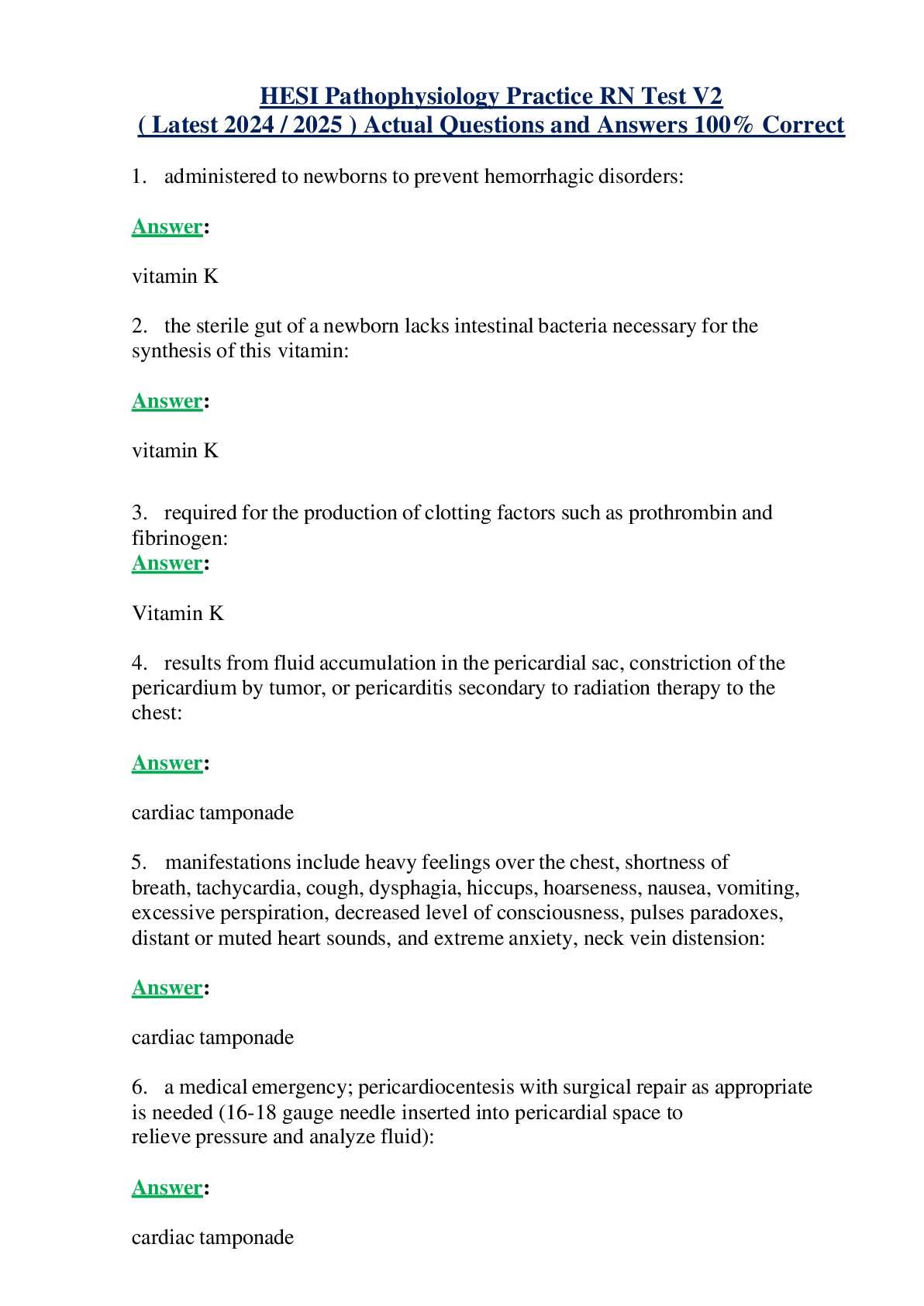
PRN 221 Any% SPEEDRUN Ver 2.0 - Questions and Answers
$ 18

HESI Pathophysiology Practice RN Test V2 ( Latest 2024 / 2025 ) Actual Questions and Answers 100% Correct
Anthropology > QUESTIONS & ANSWERS > ANTH 170C1 Exam 1 Clicker Questions (All)
ANTH 170C1 Exam 1 Clicker Questions Exam 1 Adaptation by Natural Selection Which of the following does not describe humans? True or False: Humans share an ancestor with all currently exis ... ting bacterial (type of prokaryote) cells? Approximately when did the ancestor of all life on earth live? The ancestor of all modern Homo sapiens lived around Natural selection is a/an: (is someone or something doing natural selection or is it just happening)? What are the 3 conditions for Natural Selection? _____ is the mechanism whereby having stretches of DNA that enable better abilities to create copies of oneself (reproduce), leads to more of those stretches of DNA in future generations. The process whereby different versions of those stretches of DNA change in frequency within a population is called _____. Is natural selection occurring in human populations currently? When will natural selection have the largest effect? When do you think (no incorrect answer) natural selection has had the largest effect on humans? What do you think is the unit of selection for natural selection? What is the unit that evolves? Which individuals are likely to leave more descendants? Individuals who can: Natural Selection cont. and the EEA _____ is the process whereby future generations exhibit changes in gene frequencies. This happens either due to random events, also known as genetic drift, or due to _____. In the latter, certain individuals have _____ that enable them to be more successful at _____. True of False: The goal of natural selection is to produce organisms that are best suited to their environment In an evolutionary sense, the term fitness refers to: Which of the following lists the types of natural selection in the correct order from left to right? Under stabilizing selection, which individuals have the highest reproductive success/fitness? Under directional selection a trait starts to show _____ (within a population over time), while under disruptive selection a trait becomes _____ (within a population over time). What is the main EEA for the human trait of large brains? Which lifestyle is the likely EEA for most of humans’ derived (new) traits since their split from a common ancestor with chimpanzees? Bipedalism is _____ trait in humans relative to the time when we last shared a common ancestor with Orangutans, gorillas, and chimpanzees? Bipedalism is _____ trait in humans relative to the time when we last shared a common ancestor with Neanderthals? Traits that are similar in two species because those species both inherited the trait from an ancestor who had that trait are known as _____ traits. Traits that are similar in two species because those species both evolved similar solutions to similar environmental challenges are known as _____ traits. Traits that are new to a lineage relative to a particular time are known as _____ traits. Traits that are not new to a lineage relative to a particular time are known as _____ traits. The Evolution of Cooperation A behavior that benefits the recipient but costs the actor is _____, while a behavior that costs the recipient and benefits the actor is _____. When both parties benefit we call it _____. True or False: An individual who cooperates with any and everyone is likely to have higher reproductive success than someone who discriminates and only cooperates with individuals who possess certain traits? Inclusive fitness refers to: Would a behavior that cost you 4 reproductive units and benefitted your half brother by 9 reproductive units be adaptive? (rb>c) If the cost to the actor is 3 reproductive units, and the recipient is the actor’s granddaughter, how big does the benefit have to be in order for the behavior to be selective under Hamilton’s rule (rb>c)? Kin selection helps explain why seemingly altruistic behaviors should be adaptive by: What is r (for rb>c) for an aunt and her niece? Why might grandparents be notorious for spoiling grandkids if they are only related to their grandkids by and average of 25%? Kin selection provides a theoretical explanation of how which types of behaviors could evolve? Reciprocity: sometimes if an individual cheats on his/her cost, they will be punished. An interaction where an actor punishes a recipient can best be categorized (in the short term) as what class of interaction: Reciprocity: sometimes if an individual cheats on his/her cost, they will be punished. An interaction where an actor punishes a recipient may best be categorized (in the long term) as what class of interaction: Do you think natural selection would favor an individual who helps others in group/species at a net cost to his/her fitness? (= group selection) (no wrong answer) If a group of altruists is invaded by a selfish individual, who will pass on the most genes in that group? Do you think that an ability to cooperate likely selected for empathy and a sense of fairness or the other way around? Do you think that human cooperation is qualitatively different that nonhuman cooperation? The Order Primates A trait that is new to a lineage relative to a specific point in time is referred to as a/an: A trait that is found in two organisms and also found in their most recent common ancestor is most likely a/an: A trait that is found in two organisms but is not found in their most recent common ancestor is most likely a/an: Which of the following is not a trait common to most primates? True or False: Strepsirhines are more closely related to humans than Haplorhines? Which group of primates are tarsiers most closely related to? _____ Given that no other primates have prehensile tails and giving birth to twins is very rare, these traits are likely _____ in NWMs/platyrrhines Which type of primates are we most closely related to? (which primate do we share the most recent common ancestor)? What kind of traits are short arms in humans relative to the last common ancestor of the hominoid family? If short arms are a derived trait since the last common ancestor of the hominoid family, when and where did this trait likely evolve? To which type of primate are we mostly closely related? What is the best way to describe the style of locomotion used by the living apes including gibbons, orangutans, gorillas, chimpanzees, and bonobos (but not humans) when they move through the trees? Which great ape is strictly arboreal and lives alone or with dependent offspring only? True or False: The chimpanzee that is dominant is always the largest and/or strongest male? Which of the following traits is homologous in humans and chimpanzees? (choose all that apply) What do the dates in the figure to the right refer to? Which type of primate evolved first? Why is this marmoset biting holes in this tree trunk? According to the video, why do monkeys live in groups? (choose all that apply) [Show More]
Last updated: 3 years ago
Preview 1 out of 12 pages

Buy this document to get the full access instantly
Instant Download Access after purchase
Buy NowInstant download
We Accept:

Can't find what you want? Try our AI powered Search
Connected school, study & course
About the document
Uploaded On
Mar 12, 2021
Number of pages
12
Written in
All
This document has been written for:
Uploaded
Mar 12, 2021
Downloads
0
Views
118
Scholarfriends.com Online Platform by Browsegrades Inc. 651N South Broad St, Middletown DE. United States.
We're available through e-mail, Twitter, Facebook, and live chat.
FAQ
Questions? Leave a message!
Copyright © Scholarfriends · High quality services·